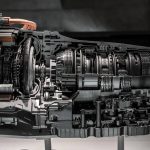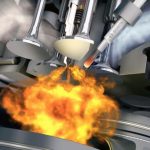Normally to shift gears you’d roll off the throttle slightly and pull in the clutch, because the transmission needs to be unloaded for the cogs in the gearbox to slide into the next position. With a quickshifter, that momentary unloading of the transmission is achieved by manipulating the ignition spark. Here’s how it works: There’s a sensor integrated into the shift linkage that detects when the shifter moves and cues the bike’s ECU to interrupt spark. So right as you’re toeing the shifter there’s a milliseconds-long cut in power that lets those gears down in the transmission shift over on their shafts, no clutch or throttle blip required.

Working of a motorcycle quickshifter
There’s a sensor integrated into the shift linkage that detects when the shifter moves and cues the bike’s ECU to interrupt spark. So right as you’re toeing the shifter there’s a milliseconds-long cut in power that lets those gears down in the transmission shift over on their shafts, no clutch or throttle blip required.
The factory-fit quickshifter on most current motorcycles uses a switch in-line with the rod that connects the gear-lever to the gearbox. In the case of the most common – an upshifter – as the lever is pushed up (on a race box it’s pushed down), the switch is first compressed and contact made. A spring adds weight to that switch, but once compressed and contact is made (or broken, depending on whether the switch is normally-open or normally-closed), the force being applied to the lever is transferred to moving the selector inside the gearbox, and the next gear ratio is selected.
It’s a simple design, but it relies on a positive shift being made by the rider, and it takes away the direct feel of a solid linkage rod, as you’re introducing a degree of sprung travel to the system.
Activation of the switch causes the spark plugs to be momentarily cut, ceasing drive. It’s the same process (but faster) as briefly rolling off the throttle while you flick into the next gear.
When the engine is driving the bike forward, the gears are being pushed by the crank. If you rolled off the throttle for long enough (or cut the power to the spark plugs) the bike would start to decelerate, and the momentum of the rear wheel would end up seeing it driving the crank through the gearbox, so acting in the opposite direction on the gears. Between those two moments – as the engine speed decreases and matches the speed of the gears when they’re driven by the rear wheel – the gearbox has a moment of ‘float’, where the dog teeth that engage the gears are between each other.

